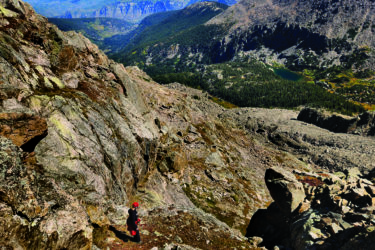The Local newsletter is your free, daily guide to life in Colorado. For locals, by locals.
Knowing the vocabulary of hunting not only ensures you won’t sound like a goof around the campfire, it also makes you a better sportsperson.
Here, 15 terms to know before you begin stalking.

Read More: How To Get Started Hunting in Colorado
Bag limit
The quota CPW sets for kills of a certain species. For example, in 2023, hunters were only allowed to harvest three rooster pheasants each day but could take up to eight quail.

Blind
A structure that hides a hunter. They can be located on the ground (behind natural terrain such as a log or an artificial tentlike edifice) or elevated in a tree.
Calling
Mimicking animals’ sounds to draw wildlife closer to you. Common examples include elks’ bugles, turkey hens’ yelps, and ducks’ quacks.
Clean kill
A shot through an animal’s vital organs, which results in a quick death—the goal of all sportspeople. Conversely, a gut shot enters through the entrails and leads to a slow, painful demise for the animal.
Draw
The lottery that determines allotment of limited licenses. Colorado organizes two for each species a year.
Drop camp
A temporary headquarters used as a base of operations while stalking a particular area, usually in the backcountry.
Field dressing
The act of removing a carcass’ entrails and internal organs following the kill to cool the meat and reduce spoilage.
Flushing
A technique in which some members of a hunting party walk toward an area in the hope of startling birds into flight, where they are easier targets.
Harvest
Although this term might conjure pastoral images of gathering crops come autumn, when applied to hunting, it means, simply, to kill an animal for food.
Muzzleloader
Hunters looking for a challenge often embrace the firearms of the Founding Fathers. Muzzleloaders require inserting the powder and projectile directly into the barrel, rendering them slower, less powerful, and less accurate than rifles. They can only be used during specific seasons
Processing
Colorado law requires hunters to prepare animals they harvest for consumption; processing is the fancy name for transforming meat into hamburger patties, steaks, sausages, or jerky.
Posting
This method of hunting means a hunter stays in a single spot and waits for game to come into range. It’s best employed with a blind or other cover, when you have studied the terrain, and when you know where wildlife crosses in a certain area. It can also be called ambush or stand hunting.

Still hunting
A strategy that involves walking and then staying, well, still as you survey the terrain around you. It’s most successful when the hunter uses cover and spends 10 times longer being still than walking.
Stalk
Hunting by tracking—following broken brush, tracks, or noises. But that noise you heard could be another hunter, so avoid this technique in call-heavy pursuits, such as turkey hunting.
Tag
What hunters often call their licenses. In Colorado, it also refers to the portion of the license that must be removed and attached to the carcass to ensure you don’t kill more critters than you were allotted.
More on “Field Dressing”
The squeamish need not apply.

Whether you call it gralloching or field dressing, removing an animal’s still-warm entrails can be a little nasty. OK, a lot nasty. You’ll need to get over it, though—and quickly. At field dressing’s most basic, it requires a hunter to slice open an animal’s belly and remove the blood and internal organs. This cools down the kill, reducing the proliferation of bacteria often caused by heat above 40 degrees. Working quickly and cleanly—dirt and moisture can lead to spoilage, too—hunters often quarter the animal, slip the parts into a game bag, and haul out what can be as much as 400 or 500 pounds of meat (depending on the animal) to a wild-game processor. If you’re hunting on private land, you can load your kill into a truck or ATV. But many public spaces don’t permit motorized vehicles beyond a certain point, so you’ll have to haul the body out using human power. (Field dressing lightens the load, but the load isn’t light.) Whatever method hunters deploy, the law doesn’t mind if you leave the bones and entrails behind for the vultures to fight over.
More on “Processing”
A visit to your friendly neighborhood processor completes the wilderness-to-table journey.
Trophy hunting, as in taking animals solely for sport, isn’t most Coloradans’ bag. Even if it were, a state statute requires that hunters turn their harvests into consumable meat. Fortunately, processing wild game into palatable portions is as simple as finding a processor.
One such provider, 48-year-old Steve’s Meat Market in Olde Town Arvada, divvies up about 4,500 carcasses per year; its basic package includes burgers, steaks, and roasts, all vacuum-sealed and (if desired) flash-frozen for long-term storage. The price: $1.60 per pound, and customers can expect about 60 percent of the total weight of the carcass to yield comestible portions. More specialized products, such as sausage and jerky, cost more.
The difficult part is getting the harvest to the processor in time to avoid rotting—a task that’s become more difficult as temperatures rise. “We have seen a huge change in our weather in Colorado,” says Steve’s co-owner Trev Stuckey, who recommends skinning the animal and getting it into a cooler quickly to ensure the carcass cools faster. With autumn and winter staying hotter longer, he adds, hunters have taken to bringing generator-fueled freezers with them on hunts. But the most surefire way to keep your meat from going bad before you have a chance to enjoy it is to field dress it properly and make a beeline for the processor. Also: “You can never have too much ice,” Stuckey says








